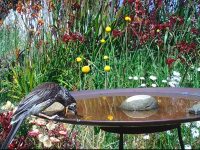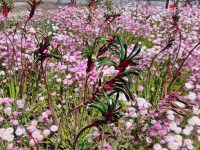As we begin 2023 the desire to look after our environment is something we can all get excited and busy about at a personal level, and especially in our backyards and other local areas that we may be the custodians of.
Biodiversity was the subject of a United Nations conference in Canada to bring down the curtain on 2022, where the nations of the world made large scale commitments to preserving biodiversity. Its importance to the future of humanity and life on earth is one that we can all get involved in, both in supporting politicians who prioritise it at a national and international level, but also by planting gardens that encourage and preserve local biodiversity.
About 6 years ago, I moved onto my farm in Tasmania, it adjoins a large area of bushland that is home to an incredible array of wildlife such as Tasmanian devils, potoroos, wombats, echidnas, bandicoots, swift parrots, wedge tail eagles, swamphawks, green rosellas, wrens, finches and much more. The biodiversity of fauna here obviously depends on the flora that supports it. So I have made it my mission to create a garden and arboretum that will complement this biodiversity, planting a mixture of local species such as Tasmanian blue gum (Eucalyptus globulus), manuka tea tree (Leptospermum scoparium), Cape Pillar She-oak (Allocasuarina crassa), and various melaleucas, pomaderris. I am also planting Western Australian species such as kangaroo paws (Anigozanthos species), waxflowers (Chamelaucium species), flowering gums (Corymbia ficifolia) that are well suited to the climate here and are great habitat as well. Plus lots of native plant cultivars such as grevilleas, tea trees and correas to create not only food, but shelter and nest boxes. A Mallee Design copper birdbath provides an ongoing safe source of water for the birds that come to my garden too.
What can you do to encourage biodiversity in your garden?
If we think of our gardens as ecosystems we can create a truly diverse habitat that can potentially support a very wide range of fauna as well as flora. To do this we need to look not only at the plants we grow, but also provide things like water, shelter and and potential homes such as nesting sites for birds. Doing our best to exclude predators such as feral cats and foxes is also an obviously desirable goal as well.
We can choose planting combinations that not only introduce plant biodiversity to your garden, but are also chosen to provide a balance for the animal kingdom as well including birds, reptiles, earthworms and insects. And, of course we must not forget the microflora of organisms such as fungi and bacteria that are so vital to natural ecosystems. Finding the right balance will also help ensure that damaging pest species are kept in balance, hopefully eliminating the need for using harsh chemicals in the garden.
There are obvious plants such as nectar-rich grevilleas and kangaroo paws that provide a concentrated energy source for birds such as honeyeaters, wattlebirds and spinebills. Other plants can be chosen to attract butterflies, beetles, bugs and other insects that are often attractive in their own right, but are also a food source for some of the other fascinating small birds such as wrens and finches that are disappearing from urban areas around Australia.
We have very carefully curated the Gardening with Angus plant range to create numerous options for encouraging biodiversity in your garden. We sell packs of 8 that each have a particular theme, with some of those being aimed at increasing the biodiversity of your garden. There are packs of plants that will encourage pollinators or attract the insects that provide food for those small birds that we can help restore to urban gardens. There are packs of nectar rich plants for birds. There are plants to provide cut flowers as well as habitat. There are hard to get Tall and Tough kangaroo paws. Our plant selections have also been chosen to be relatively easy care varieties that will also look good. They are forestry tube sized plants, which are a cost effective way to buy plants….check out the range here>>>>
Habitat Stepping Stones is a program we are proud to say we have supported since its inception 10 years ago, and it is a fabulous resource that can help you on your biodiversity journey in the garden. We would also encourage you to look at the beautiful Mallee Design copper dish birdbaths that can also form an integral as well as very beautiful part of your garden habitat.
The Gardening With Angus seed collection is another way of increasing biodiversity in your garden. Each seedling you raise is genetically unique and it is a great way to educate children about biodiversity. Collecting your own seed is another important way to encourage biodiversity in your garden but we will leave that subject to next month’s newsletter.
Happy gardening from Angus and the GWA team



